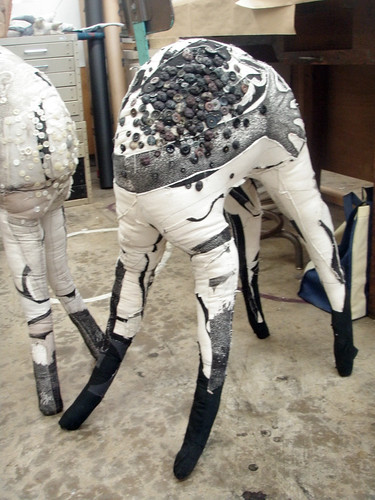
The miniature is defined by its physicality. The only ways to describe the miniature is through ratio and relationship to other objects: the story of Tom Thumb, the fictional tiny hero, who had a walnut shell as a cradle. We are given the intimate knowledge of Tom’s size through a gluttony of vivid physical description, but only of the size of Tom.

In the painting class, one of the students showed his recent work which included a miniaturized copy of a Franz Kline painting. The discussion of the piece was largely a discussion of ratio—the size of Kline’s brush compared to the size of the brush Jordan used, the difference in studio size, canvas used, etc. Everyone found the painting funny because it was small, a joke that one only “gets” if one already possesses knowledge of the large painting that was copied. The miniature is not only defined by its physicality, but also by its familiarity. You cannot see a miniature something if you have never see a normal sized something before. Without foreknowledge of the miniaturized item the miniaturization is undetectable. I am in on the joke of the miniature Kline painting, but my own experience with Kline’s work, I realize long after my “in crowd” chuckling, are of photographic reproductions, images that are even smaller than Jordan’s reduced painting.

The miniature is of the antique and the timeless, a tiny piece signifying timelessness, whereas the giant is most often involved only when his, and the giant is usually a male, death or defeat is predetermined. Cyclops was blinded by Odysseus, King Arthur and his cronies battled and killed numerous unnamed giants, and even London’s Og and Magog are defeated and chained, forced into servitude. In Gulliver’s Travels, Gulliver, when in the land of Brobdingnag, home of the giant people, was perpetually confronted with the repulsive nature of humanity. The breasts of the giant women are mentioned at numerous intervals, the breast being the most idealized part of the female anatomy they are the perfect example of the horridness of the large. The color, the odor, and the sheer size of the breasts of the aristocratic giants are described in lavish disgusting detail, and just in case that were inadequate, Gulliver also throws in the tail of seeing a beggar beset with breast cancer. The breasts of the giants are so large that Gulliver can only see one at a time and only a small part of it--the nipple surrounded by downy hair a hideous furry hillock--this all encompassing experience is grotesque.

No comments:
Post a Comment